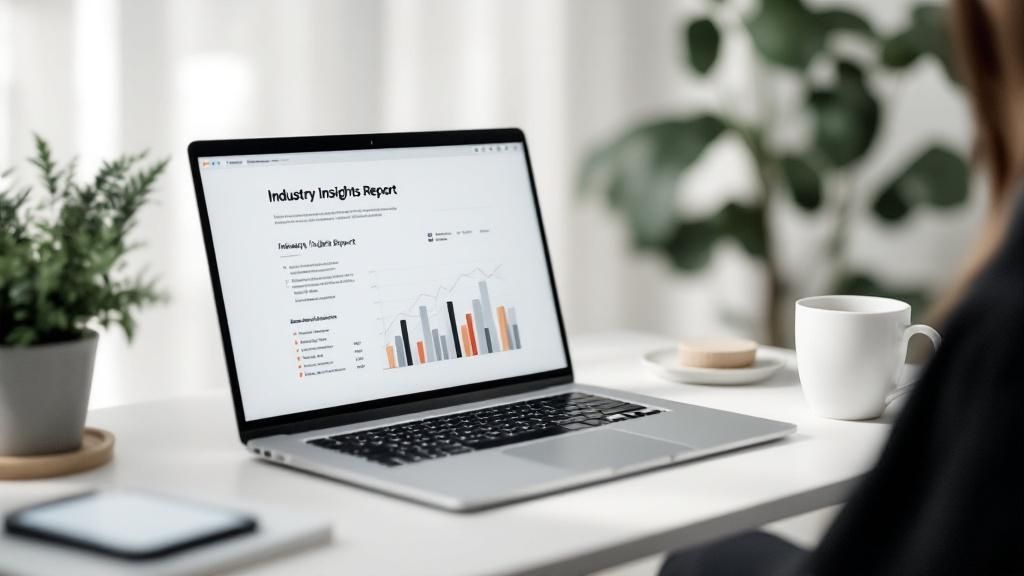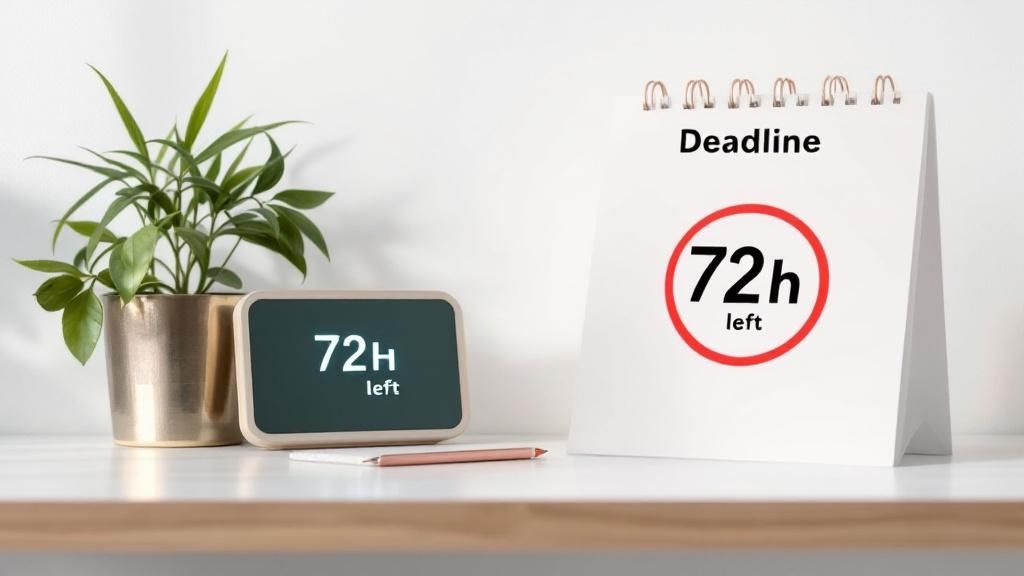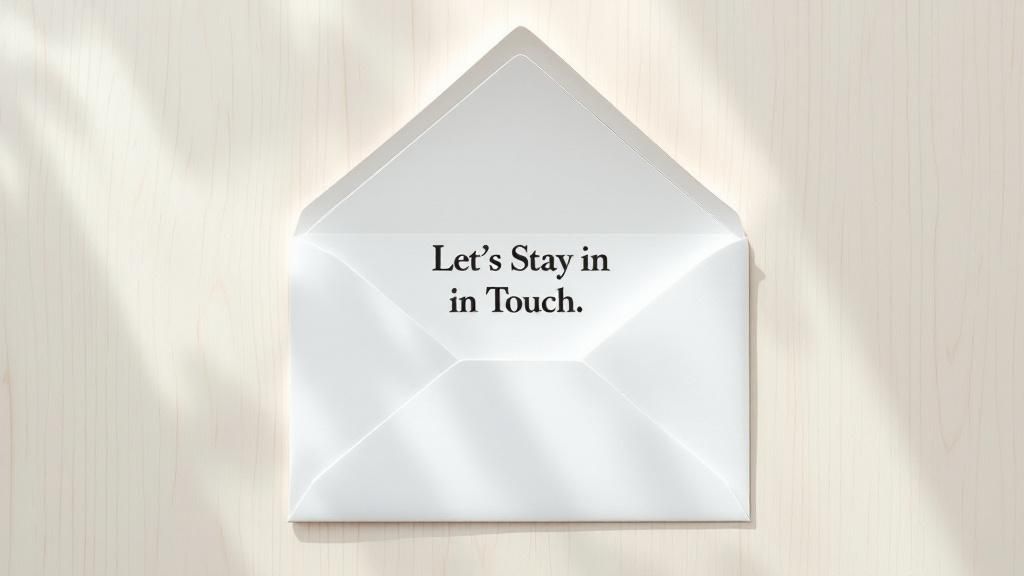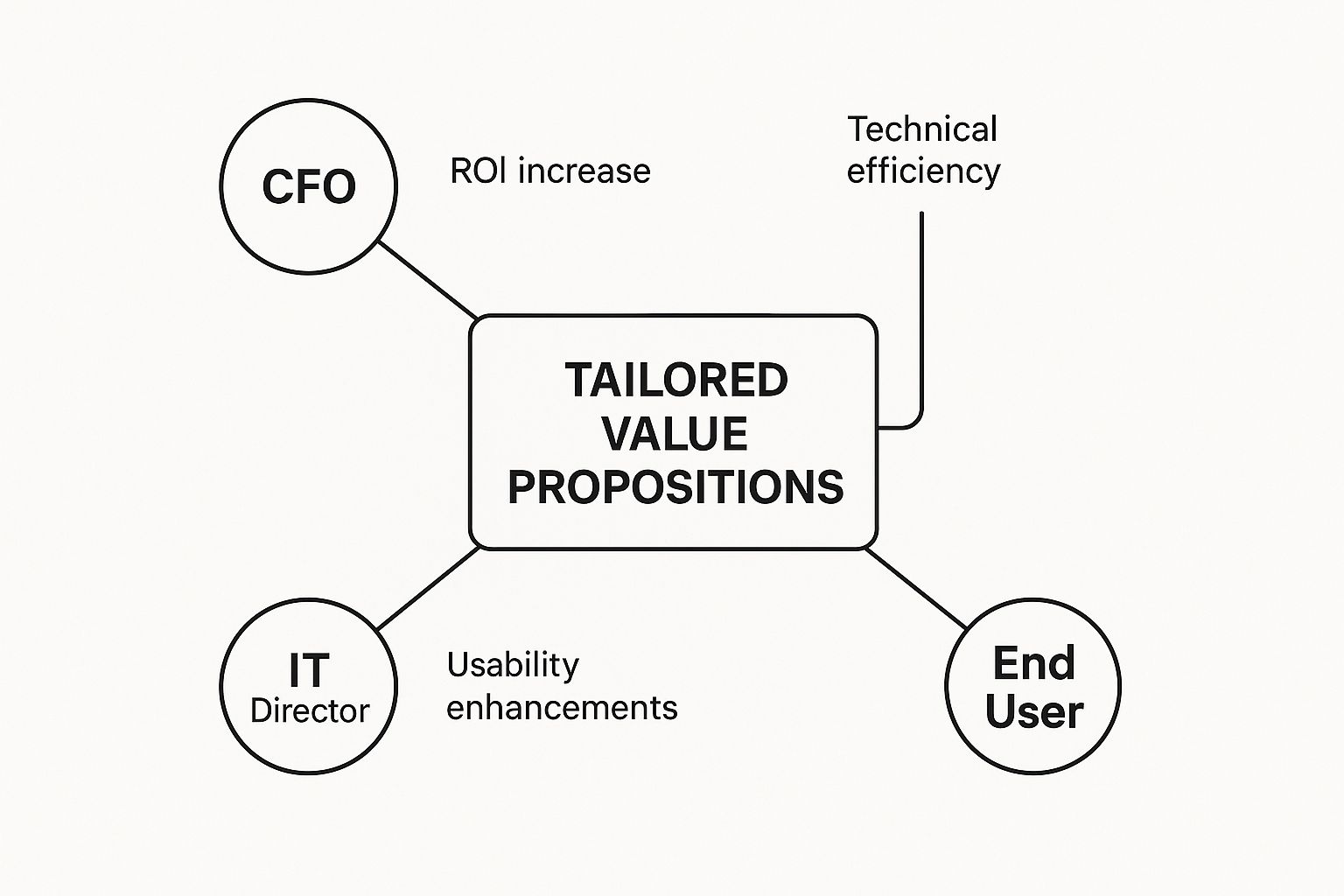In the world of sales, the follow-up is where deals are won or lost. A generic "just checking in" email is the fastest way to the trash folder. Prospects are inundated with messages, and only the most relevant, valuable, and strategic communication cuts through the noise.
The difference between a stalled deal and a signed contract often comes down to the quality of your follow-up sequence. Of course, a strong follow-up relies on a solid first impression. Before diving into these sequences, it's crucial to ensure your initial communications are effective, and you can learn more about mastering cold email outreach that converts. This foundational step makes your subsequent messages far more impactful.
This guide moves beyond basic templates to provide a strategic breakdown of 7 powerful sales follow up emails examples. We'll dissect what makes each one effective, offer actionable templates you can adapt, and provide expert analysis to help you craft messages that re-engage prospects and accelerate your sales cycle. From providing immediate value to creating legitimate urgency, these examples are designed to get you noticed and, more importantly, get a response. By mastering these techniques, you'll transform your follow-up process from a routine task into a powerful conversion tool.
1. The Value-First Follow-Up Email
The Value-First Follow-Up is a powerful strategy that shifts the focus from "what can you do for me?" to "how can I help you?". Instead of immediately asking for a meeting or a decision, this approach involves providing something genuinely useful to your prospect. This positions you as a trusted advisor and industry expert, not just another salesperson.
This method, often associated with methodologies like the Challenger Sale and championed by sales leaders at HubSpot, builds rapport and demonstrates your expertise. By delivering value upfront, you earn the prospect's attention and trust, making them far more receptive to your eventual pitch. It’s one of the most effective sales follow up emails examples because it prioritizes the relationship over the transaction.

Strategic Breakdown
- Objective: Build credibility and trust by offering valuable, no-strings-attached resources.
- Core Tactic: Share relevant content, insights, or tools that directly address a prospect's known challenges or goals.
- Psychological Principle: This leverages the principle of reciprocity. When you give something of value, people feel a natural inclination to give something back, such as their time or attention.
Example Template
Subject: Thought you'd find this [Resource Type] helpful, [Prospect Name]
Hi [Prospect Name],
Following up on our conversation about [specific challenge discussed], I came across this recent report on [Industry Trend] that sheds some light on how companies are tackling it.
The key takeaway on page 7 about [Specific Insight] seemed particularly relevant to your goal of [Prospect's Goal].
You can find the full report here: [Link to Resource]
Hope this is useful for you and your team.
Best,
[Your Name]
Actionable Takeaways
- Personalize the Value: Don't send generic resources. The value must be directly tied to a specific pain point or conversation you've had with the prospect. Mentioning a specific page or data point shows you've done your homework.
- Keep the Ask Soft (or Non-Existent): The primary goal is to be helpful. Avoid a hard call to action like "Let's book a call to discuss." Let the value speak for itself and build the foundation for a future ask.
- Track Engagement: Use link tracking to see if the prospect opened your resource. This engagement is a strong buying signal and gives you a perfect reason to follow up again with a more direct call to action.
2. The Social Proof Follow-Up Email
The Social Proof Follow-Up email is a strategy that relies on external validation to build trust and mitigate risk for the prospect. Instead of telling them how great your solution is, you show them by highlighting the success others, particularly those in similar situations, have achieved. This approach shifts the conversation from your claims to proven, real-world results.
This powerful technique is rooted in principles outlined by Robert Cialdini in "Influence" and is a cornerstone of modern sales methodologies used by giants like Salesforce. By providing evidence that peers have already vetted and succeeded with your solution, you lower the perceived risk for the prospect and make the decision to move forward feel safer and more logical.
Strategic Breakdown
- Objective: Increase credibility and reduce purchase anxiety by showcasing the success of similar customers.
- Core Tactic: Share case studies, testimonials, or data points from customers who match the prospect's industry, company size, or specific challenges.
- Psychological Principle: This method leverages social proof, the idea that people will conform to the actions of others under the assumption that those actions are reflective of the correct behavior. When a prospect sees a competitor succeeding with your product, they feel more confident in making the same choice.
Example Template
Subject: How [Similar Company] solved [Specific Challenge]
Hi [Prospect Name],
During our last chat, you mentioned the challenges your team is facing with [Prospect's Pain Point]. It reminded me of the situation [Customer Name], another leader in the [Prospect's Industry] space, was in before they partnered with us.
They were able to achieve a [Specific, Quantifiable Result, e.g., 40% reduction in operational costs] within just six months. We put together a brief case study detailing exactly how they did it.
You can see the full story here: [Link to Case Study or Testimonial]
Thought this might provide a clear picture of the potential impact for [Prospect's Company].
Best,
[Your Name]
Actionable Takeaways
- Relevance is Key: The power of social proof diminishes if it's not relevant. Match the example company's industry, size, and pain points as closely as possible to your prospect's. A generic testimonial won't have the same impact.
- Quantify the Results: Vague claims like "improved their process" are forgettable. Use hard numbers and specific metrics like "decreased lead response time by 35%" or "increased pipeline by $2M." Data-driven proof points are more compelling and memorable.
- Vary Your Proof: Don't just send case studies. Mix in different forms of social proof like short video testimonials, quotes from G2 or Capterra reviews, or even a simple mention that you're working with their direct competitor (with permission). This makes your follow-up feel fresh and dynamic.
3. The Urgency and Scarcity Follow-Up Email
The Urgency and Scarcity Follow-Up is a strategic email designed to motivate a prospect who is on the fence. Instead of focusing on what they gain, this approach highlights what they stand to lose by delaying their decision. It introduces a legitimate, time-sensitive element that encourages immediate action.
This method, rooted in classic direct response marketing principles from experts like Dan Kennedy, leverages powerful psychological triggers. When prospects perceive that an opportunity like special pricing or exclusive availability is limited, it compels them to prioritize the decision. Done correctly, it's one of the most effective sales follow up emails examples for accelerating a stalled deal without being pushy.

Strategic Breakdown
- Objective: Overcome decision paralysis and prompt a final decision from a late-stage prospect.
- Core Tactic: Introduce a genuine reason for the prospect to act now, such as an upcoming price change, expiring offer, or limited implementation slots.
- Psychological Principle: This tactic relies on Loss Aversion and the Fear of Missing Out (FOMO). People are often more motivated by the fear of losing something than by the prospect of gaining something of equal value. To dive deeper, you can explore some effective FOMO marketing strategies on salesloop.io.
Example Template
Subject: Quick heads-up regarding the [Proposal/Quote] for [Prospect Company Name]
Hi [Prospect Name],
I'm following up on the proposal we discussed for [Product/Service]. I wanted to let you know that our current pricing structure is being updated at the end of the month.
Any agreements signed after [Date] will be subject to the new rates, which will be approximately 10% higher.
If you'd like to lock in the current pricing, we would just need to get the signed proposal back by [Deadline Date]. Let me know if you have any final questions I can answer before then.
Best,
[Your Name]
Actionable Takeaways
- Maintain Authenticity: The urgency must be real. Fabricating deadlines will damage your credibility and erode trust. Use real business reasons like end-of-quarter initiatives, upcoming price adjustments, or a full implementation calendar.
- Be a Consultant, Not a Threat: Frame the deadline as a helpful heads-up, not an ultimatum. Your tone should be, "I want to make sure you get the best deal," rather than, "Buy now or else."
- Provide a Clear Path to Action: Don't leave the prospect guessing. Clearly state what they need to do to take advantage of the offer (e.g., "sign the attached proposal," "book a final call here") and the exact deadline.
4. The Breakup Email
When all other follow-up attempts have been met with silence, the Breakup Email serves as a final, strategic move. Instead of continuing to pursue an unresponsive prospect, this email politely signals that you are closing their file and ceasing your outreach. This approach leverages reverse psychology to provoke a response, often re-engaging prospects who were simply too busy to reply earlier.
This technique, popularized within the Sales Hacker community and a staple of modern sales development, works because it respects the prospect's time and removes the pressure of a persistent salesperson. It's a powerful tool in your toolkit of sales follow up emails examples because it can either generate a last-minute response or allow you to cleanly move on to more promising leads.

Strategic Breakdown
- Objective: To provoke a final response from an unresponsive prospect by creating a sense of urgency or loss.
- Core Tactic: Politely inform the prospect you are closing their file and will no longer be following up, while leaving the door open for future contact.
- Psychological Principle: This tactic relies on the principle of loss aversion. People are more motivated by the fear of losing something than by the prospect of gaining something of equal value. The idea that the opportunity to connect is disappearing can trigger action.
Example Template
Subject: Permission to close your file?
Hi [Prospect Name],
I've reached out a few times to connect about [Prospect's Goal/Company Initiative] but haven't heard back, which usually means one of two things: either your priorities have shifted, or now isn't the right time.
In either case, I don't want to clog up your inbox. I’m going to go ahead and close your file for now.
If you find that [solving the original pain point] becomes a priority again in the future, please feel free to reach out.
All the best,
[Your Name]
Actionable Takeaways
- Use as a Last Resort: This email should only be sent after a series of unanswered follow-ups (typically 3-5 attempts). Using it too early negates its psychological impact and can come across as passive-aggressive.
- Maintain a Positive Tone: The goal is to be professional and helpful, not to guilt-trip the prospect. The tone should be one of understanding and respect for their time. For more tips on crafting the right tone, you can learn more about handling non-responses on salesloop.io.
- Make Re-engagement Easy: Clearly state that the door is always open. This removes friction and makes it simple for a prospect to pick up the conversation later if their circumstances change, preserving the potential for a future relationship.
5. The Multi-Threading Follow-Up Email
The Multi-Threading Follow-Up moves beyond a single point of contact to engage multiple stakeholders within a prospect's organization. This strategic approach acknowledges that modern B2B buying decisions are rarely made by one person. Instead, it involves building consensus across a buying committee by tailoring your message to the unique priorities of different roles.
This method is a core component of advanced sales frameworks like the Challenger Sale methodology and MEDDIC. By engaging decision-makers, influencers, and end-users simultaneously, you de-risk the deal and build internal champions for your solution. It’s one of the most sophisticated sales follow up emails examples because it transforms your outreach from a single conversation into a coordinated, company-wide dialogue.
The infographic below illustrates how a central value proposition is adapted for different key stakeholders.

This visualization highlights the necessity of customizing your message to resonate with the specific concerns of each role, from financial impact for a CFO to technical efficiency for an IT Director.
Strategic Breakdown
- Objective: Build widespread support and mitigate the risk of a single contact blocking the deal by engaging the entire buying committee.
- Core Tactic: Send distinct, customized follow-up emails to various stakeholders, each highlighting the value proposition most relevant to their role and responsibilities.
- Psychological Principle: This strategy utilizes social proof and consensus. When multiple influential people within an organization see value in your solution, it creates internal momentum and makes it easier for the group to reach a positive decision.
Example Template
Subject: Following up on [Primary Contact]'s interest in [Solution Area]
Hi [Stakeholder Name],
My colleague [Your Name] has been speaking with [Primary Contact] in the [Primary Contact's Department] about their goal to [Company Goal].
Knowing your focus is on [Stakeholder's Responsibility, e.g., financial oversight], I wanted to share a brief case study on how we helped [Similar Company] achieve a [Relevant Metric, e.g., 25% reduction in operational costs].
We believe a similar approach could help [Prospect Company] achieve its financial targets. Would you be open to a brief 15-minute call next week to explore this potential ROI?
Best,
[Your Manager's Name or Your Name]
Actionable Takeaways
- Map the Buying Committee: Use LinkedIn and organizational charts to identify key players. Look for the economic buyer (CFO), technical buyer (IT Director), and end-users or champions who will benefit daily from your solution.
- Customize the Value Prop: Don't send the same email to everyone. Frame your solution's benefits in their language. For a CFO, talk ROI and cost savings. For an IT lead, focus on security, integration, and efficiency.
- Name-Drop Appropriately: Referencing your primary contact shows you've done your homework and aren't just cold-emailing. It provides context and legitimacy to your outreach to other stakeholders.
6. The Trigger Event Follow-Up Email
The Trigger Event Follow-Up capitalizes on a specific event or change within a prospect's company or industry. Instead of a cold outreach, you use a recent, relevant development as a powerful and timely reason to connect. This demonstrates you are actively engaged with their business world and can adapt your value proposition to their current situation.
This approach is a cornerstone of modern sales development, heavily promoted by platforms like LinkedIn Sales Navigator and supported by research from companies like Salesloft. It positions you as an informed and proactive partner. By linking your outreach to a real-world event, you immediately establish relevance and urgency, making this one of the most effective sales follow up emails examples for cutting through the noise.
Strategic Breakdown
- Objective: Demonstrate relevance and timeliness by connecting your solution to a specific, recent event impacting the prospect's business.
- Core Tactic: Monitor prospect companies for trigger events (e.g., funding, new hires, expansion, new regulations) and craft a message that aligns your offering with the new opportunity or challenge.
- Psychological Principle: This leverages the principle of urgency and relevance. People are more likely to act when a message directly relates to a current event that demands their attention and presents a new priority.
Example Template
Subject: Congrats on the Series B funding, [Prospect Name]!
Hi [Prospect Name],
I saw the great news about [Company Name]'s recent funding announcement on TechCrunch. Congratulations to you and the team!
With this new capital often comes the challenge of rapidly scaling your [Relevant Department, e.g., sales] team while maintaining efficiency. Our platform helps growth-stage companies like yours onboard new reps 30% faster and automate their workflows.
Would you be open to a brief chat next week about how we can help you navigate this exciting growth phase?
Best,
[Your Name]
Actionable Takeaways
- Set Up Your Listening Posts: Actively monitor for triggers. Use Google Alerts for your target accounts, follow them on LinkedIn, and read industry publications. Timeliness is critical, so you need to be the first to know.
- Connect the Dots Clearly: Don't just mention the event. You must explicitly connect it to a challenge or opportunity your solution can address. Make it easy for the prospect to see the "why you, why now."
- Strike While the Iron Is Hot: A trigger event has a short shelf life. Your follow-up should happen within a few days of the news breaking to maximize its impact and relevance. The older the news, the less effective the outreach.
7. The Question-Based Follow-Up Email
The Question-Based Follow-Up is a direct and effective strategy for re-engaging a prospect by prompting a response. Instead of pushing your agenda or making assumptions, this approach uses open-ended questions to restart the dialogue. It puts the ball in the prospect's court, inviting them to share their current status, thoughts, or challenges.
This technique, with roots in consultative methodologies like SPIN Selling and Sandler Training, is designed to uncover new information and understand a prospect's mindset. It forces a pause from the standard sales pitch, encouraging a more collaborative and conversational exchange. As one of the most interactive sales follow up emails examples, it is exceptional at breaking through silence and getting a conversation back on track.
Strategic Breakdown
- Objective: Re-engage a quiet prospect and uncover their current priorities, challenges, or objections.
- Core Tactic: Ask a specific, open-ended question that is relevant to your previous conversations or their known business goals.
- Psychological Principle: This method leverages curiosity and the Zeigarnik effect, which suggests people remember uncompleted or interrupted tasks better than completed ones. An unanswered question creates a mental "open loop" that a prospect feels compelled to close.
Example Template
Subject: A quick question about [Prospect's Goal]
Hi [Prospect Name],
I was just thinking about our last conversation regarding your team's goal to [specific goal, e.g., improve lead generation efficiency].
It's been a little while, and I was curious: what's your biggest roadblock to achieving that goal right now?
No need for a long reply, just curious to know what's on your mind.
Best,
[Your Name]
Actionable Takeaways
- Avoid Yes/No Questions: The goal is to start a conversation, not end it. Ask questions that begin with "What," "How," or "Why" to encourage a more detailed response.
- Reference Past Conversations: Ground your question in a previous discussion or known pain point. This shows you were listening and that your question is thoughtful, not random. The key is to find the right balance for personalizing your outreach at scale.
- Keep it Singular and Focused: Don't overwhelm the prospect with multiple questions. Ask one single, powerful question that is easy to understand and answer. This respects their time and increases the likelihood of a reply.
7 Types of Sales Follow-Up Emails Compared
| Follow-Up Email Type | Implementation Complexity 🔄 | Resource Requirements 💡 | Expected Outcomes 📊 | Ideal Use Cases 💡 | Key Advantages ⭐ |
|---|---|---|---|---|---|
| Value-First Follow-Up Email | Medium – requires research and industry knowledge | Moderate – time for content creation | Builds trust and credibility; long-term engagement | Early-stage prospects needing education | Positions sender as expert; high engagement |
| Social Proof Follow-Up Email | Low to Medium – gathering testimonials and case studies | Low to Moderate – need customer permission | Rapid credibility and trust-building | Risk-averse prospects needing proof | Provides concrete validation; lowers perceived risk |
| Urgency and Scarcity Follow-Up Email | Low – simple deadline/offers setup | Low – time-limited offers and messaging | Faster decision-making; shorter sales cycle | Warm leads, promotional or time-sensitive offers | Drives quick actions; clear calls-to-action |
| Breakup Email | Low – straightforward and polite closing message | Low – minimal resources | Clears unresponsive leads; can reactivate cold prospects | Unresponsive or stalled prospects | Maintains professionalism; respects prospect time |
| Multi-Threading Follow-Up Email | High – requires stakeholder mapping and role-specific messaging | High – research multiple contacts and customize | Greater organizational buy-in; reduced risk | Complex B2B sales with multiple decision makers | Engages diverse stakeholders; accelerates consensus |
| Trigger Event Follow-Up Email | Medium to High – requires ongoing monitoring and personalization | Moderate to High – constant research needed | Timely relevance; high engagement moments | Prospects with recent business changes | Demonstrates interest and business acumen |
| Question-Based Follow-Up Email | Medium – crafting thoughtful, strategic questions | Moderate – requires skill in question design | Encourages dialogue; uncovers needs | Prospects where relationship building is key | Positions seller as consultant; less pushy |
Automate Your Strategy, Not Your Relationships
Navigating the world of sales requires more than just a good product; it demands persistent, strategic, and human-centric communication. Throughout this article, we’ve dissected seven powerful sales follow up emails examples, moving beyond generic templates to uncover the underlying strategy that makes them effective. From providing immediate value and leveraging social proof to creating urgency and executing a graceful breakup, each example serves a specific purpose in your sales cadence.
The core lesson is clear: effective follow-ups are not about pestering prospects. They are about continuing a valuable conversation, demonstrating your understanding of their challenges, and positioning yourself as a helpful resource. The best emails are personalized, relevant, and timed to perfection.
From Knowledge to Action: Systematizing Your Follow-Up
Mastering these email types is the first critical step. However, the true challenge lies in implementing them consistently and at scale without losing the personal touch. Manually tracking every prospect, remembering when to send the Trigger Event email versus the Multi-Threading email, is an impossible task for any busy sales professional. This is where process and technology become your strategic allies.
The goal is not to automate your relationships, but to automate the mechanics of your outreach strategy. This frees up your time and mental energy to focus on what truly matters: building genuine connections with highly engaged prospects. By creating a system, you ensure that no lead falls through the cracks and every prospect receives a thoughtful, timely follow-up that moves the conversation forward.
Key Takeaways to Implement Today
To transform these examples into a repeatable engine for growth, concentrate on these principles:
- Map Your Cadence: Don't send emails randomly. Design a sequence that logically progresses, perhaps starting with a Value-First email, followed by a Social Proof touchpoint, and concluding with a Breakup email if there's no response.
- Personalization at Scale: Use prospect data (like industry, job title, or recent company news) to tailor your templates. A single personalized sentence can dramatically improve your response rates.
- Test and Iterate: Your initial sequence won't be perfect. Track your open rates, reply rates, and conversion rates for each email type. A/B test your subject lines and calls to action to continuously refine your approach.
- Combine with Other Channels: The most effective follow-up strategies are multi-channel. Complement these powerful email examples with LinkedIn connections, phone calls, or even personalized videos to stand out in a crowded inbox.
Ultimately, mastering the art of the follow-up is what separates top-performing sales professionals from the rest. It’s a testament to your professionalism, your respect for the prospect's time, and your unwavering belief in the value you provide. By implementing these sales follow up emails examples within a structured, automated system, you build a powerful and predictable pipeline that drives consistent results.
Ready to turn these powerful email strategies into an automated, scalable sales machine? Salesloop.io allows you to build sophisticated, multi-step outreach sequences using the exact templates and tactics discussed here. Stop manually tracking follow-ups and start closing more deals by visiting Salesloop.io to see how intelligent automation can transform your outreach.





